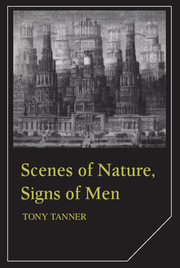Book contents
- Frontmatter
- Contents
- Preface
- 1 Scenes of nature, signs of men
- 2 Notes for a comparison between American and European Romanticism
- 3 Problems and roles of the American artist as portrayed by the American novelist
- 4 James on Hawthorne
- 5 The lost America – the despair of Henry Adams and Mark Twain
- 6 Henry James and Henry Adams
- 7 William Dean Howells and A Hazard of New Fortunes
- 8 Stephen Crane
- 9 The Bostonians and the human voice
- 10 Games American writers play: ceremony, complicity, contestation, and carnival
- 11 Toward an ultimate topography: the work of Joseph McElroy
- 12 Frames and sentences
- 13 William Gass's barns and bees
- Index
- Frontmatter
- Contents
- Preface
- 1 Scenes of nature, signs of men
- 2 Notes for a comparison between American and European Romanticism
- 3 Problems and roles of the American artist as portrayed by the American novelist
- 4 James on Hawthorne
- 5 The lost America – the despair of Henry Adams and Mark Twain
- 6 Henry James and Henry Adams
- 7 William Dean Howells and A Hazard of New Fortunes
- 8 Stephen Crane
- 9 The Bostonians and the human voice
- 10 Games American writers play: ceremony, complicity, contestation, and carnival
- 11 Toward an ultimate topography: the work of Joseph McElroy
- 12 Frames and sentences
- 13 William Gass's barns and bees
- Index
Summary
Conrad said that The Red Badge of Courage burst upon the public with ‘the impact and force of a twelve-inch shell charged with a very high explosive’. An apt image, not only for the book, but for Stephen Crane himself, who, by projecting his own inner warfares into a variety of fictional settings, exerted a decisive, and explosive, influence on the development of American literature – perhaps even on the innovations of twentieth-century prose. There had never been a book quite like The Red Badge of Courage. This is how H. L. Mencken remembers its effect on the literary atmosphere of the time. ‘It gave the whole movement of the nineties a sudden direction and a powerful impulse forward. At one stroke realism was made its goal – not the old flabby, kittenish realism of Howells's imitators … but the sterner, more searching realism that got under the surface.’ Mencken is not being quite fair to Howells, as we can learn from a letter written by Crane in 1894 in which he says:
I renounced the clever school in literature. It seemed to me that there must be something more in life than to sit and cudgel one's brains for clever and witty expedients. So I developed all alone a little creed of art which I thought was a good one. […]
- Type
- Chapter
- Information
- Scenes of Nature, Signs of MenEssays on 19th and 20th Century American Literature, pp. 133 - 147Publisher: Cambridge University PressPrint publication year: 1987

